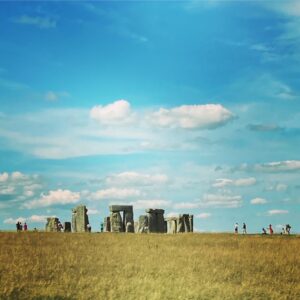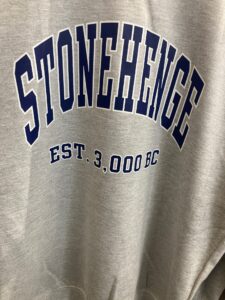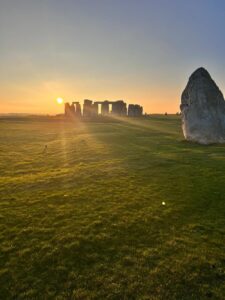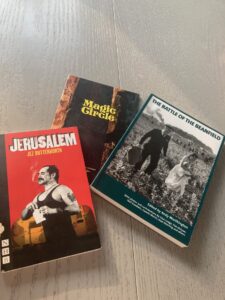Battle lines: Mark Hooper visits Stonehenge, and finds echoes of social upheaval that still resonate today.

It might be a bit disingenuous to call this a walk, given that we took the coach (helpfully marked ‘TO THE STONES’) from the Stonehenge visitor centre to the site itself. In our defence, we were juggling four reluctant children between us – a blended family carload of disinterest.
Of course, they don’t know they’re born, kids these days. When I was their age, the entire Stonehenge experience was very different. For a while in the late 70s, I lived in nearby Warminster, and a walk to the stones was a fairly regular weekend activity. I have vague memories of coming over a small rise in a mizzly, rain-fogged afternoon, and the stones suddenly appearing through the haze. With no buses laid on, this was a far quieter, more personal, contemplative way of exploring the site. Not only that, but you could touch and even sit on the stones. I don’t remember anyone of authority saying anything to us, let alone signs warning you not to fly drones overhead.
These days, having booked your slot, parked up and had your ticket scanned, you enter through the gift shop, which is an experience in itself. For those who consider this a sacred site, the over-commercialised, sell-anything-that’s-not-nailed-down approach of the gift shop might grate. Personally, I love it. Sarsen-stone neck pillows, giant Toblerones emblazoned with ‘STONEHENGE’ down the side, miniature models of the stones themselves that you can take home and build yourself, solstice key rings, witty t-shirts and baseball caps … it’s all here.

I’ll save you a review of the stones themselves. Suffice to say, if you’re not moved by them, you’re dead inside. The busloads of tourists dutifully trooping past (always anticlockwise) are here for a reason. Despite it all, you can still occasionally step away from the flow – even walk clockwise a bit – to find moments of peace, and have your breath taken away afresh. This time, these epiphanies came was at unexpected spots. For instance, I’d never fully appreciated how there’s a ‘reverse’ side to the stones, opposite to the direction of approach that ancient visitors would take, and thus more rough and ready in appearance. Or standing by the Heel Stone, the giant 36-tonne sarsen that stands apart from the circle, leaning in its direction as if pointing the way, and realizing that this isn’t an addendum to the story, but the preface – the Heel Stone is thought to predate all the other stones, and may have marked this area of Salisbury Plain out as a sacred site in the first place.
Even the kids got in on the vibe. The fact that it is all still so unknowable – prompting us all to ask ‘But why?’ ad infinitum (Why did they build it here in the first place? Why did they take bluestones all the way from Wales? Who were ‘they’ anyway? What was it for?) – makes it so compelling. There are very few answers: just more questions. In fact, the kids were so engrossed, the actually asked to walk back, resulting in a 1.7 mile stroll back across the meadow and through Fargo Wood, just northwest of Stonehenge, as we played an imaginative game of I Spy (‘COG – Clump Of Grass’; ‘H – Hole’). I realised that our walk took us right through the site of the 1984 People’s Free Festival, which attracted an estimated 30,000 people over the summer solstice in June of that year.

I’ll be honest, I don’t remember hearing about it – I was 12 at the time – but I do remember what happened the following year, because it was all over the local news. It wouldn’t be an exaggeration to say that, aged 13, it was an event which made me re-consider how I see the country. To cut to the chase, there was no Stonehenge Free Festival in 1985. That year, worried about the numbers of travellers descending on their site, English Heritage and the National Trust (who own the land adjacent to the stones) took out an injunction to prevent any gathering from taking place. As a convoy of some 150 vehicles headed off from Savernake Forest near Marlborough, approaching southwards along the A338, Wiltshire police set up a roadblock to prevent them joining the A303 westwards towards Stonehenge. Well, I say roadblock – they actually dumped 15 tons of gravel over the road, rendering it impassable, and diverting the convoy southeastwards along the B3084. As the convoy tried to join the A303 from this road, a second roadblock was put in place – this time forcing them off the road and onto a pasture field, 8 miles from Stonehenge.
The police then promptly set about smashing the windows of the vehicles, under the pretext that they were trespassing (by driving onto the land they had just been directed onto by the police). The pretext that hippies and ‘druggies’, were arriving armed with petrol bombs to cause trouble, belied the reality – they were a peaceful convoy of families, including women and children. But they were the wrong sort of people, the type that ‘respectable’ society didn’t want desecrating their land.
As I watched the reports on TV, it became pretty clear which side were the wrong sort of people. I come from a military family, I’m white and middle class. I grew up believing that the police were there to help – the ones you should go to if you’re lost or in trouble. But, that afternoon I remember for the first time consciously thinking: maybe the police aren’t the good guys.
What’s perhaps most shocking is that you can watch it all on YouTube today – not just the scenes of what happened, but also how it was edited and presented to the public. While ITV news toed the usual hippies v police line (‘The convoy crashed through roadblocks to try to get to an illegal pop festival’), their unedited raw footage (available to view online), paints a very different picture. There are plenty of eye witness accounts, but the most damning, immediate summary comes from ITN’s Kim Sibido, as he delivers a piece to camera:
‘What we’ve witnessed in the last half an hour here has been surely some of the most brutal action by police forces in Britain for a long time. Whatever the causes, the end product seemed to be just hitting out wildly by the police, with babies in those trucks and in those buses, and young women with those babies in their arms were hit as well.’
There are shocked ambulancemen detailing the injuries they had to deal with – including fractured skulls caused by truncheons. All the evidence points to the same conclusion. The police, having effectively ambushed the convoy and created a stand-off entirely of their own making, then set about beating the shit out of families who were heading for a party.
The Battle of the Beanfield, as it came to be known, has become something of a forgotten footnote in the history of civil unrest in Britain during the Thatcher years – coinciding as it did with the miners’ strikes (The Battle of Orgreave took place on the same week as the People’s Free Festival in 1984). But it was a pivotal moment for many, like me, who had viewed those events from afar (both geographically and socially). It preceded the Poll Tax Riots by five years – which in turn heralded the Criminal Justice and Public Order Act of 1994, with its eerie echoes of the Enclosures Acts of the 18th and 19th centuries in the way that it disenfranchised those on the fringes of society in favour of rich landowners.
The Battle of the Beanfield – or Operation Solstice as Wiltshire Police coined their action that day – culminated in the mass arrest of 420 people and around a dozen serious injuries to members of the public (justified by the fact that the police were purportedly protecting the public peace). Two years later, a single Wiltshire police sergeant was found guilty of causing actual bodily harm. The travellers later sued the police, alleging wrongful arrest, false imprisonment and damage to property, and in February 1991 Winchester crown court awarded 21 individuals a total of £24,000 in damages.

All of this is recorded in meticulous detail in The Battle of the Beanfield by Andy Worthington (available from www.andyworthington.co.uk). His book includes excerpts from the police radio log, interviews with Deputy Chief Constable Ian Redhead, the Earl of Cardigan, ITV’s Kim Sabado and Nick Davies of the Observer, as well as Lord Gifford QC, who represented the travellers at the 1991 trial. It’s a book that seems to come from a different time, with very different attitudes, but it has telling parallels with today, particularly with the Right to Roam and the protests on Dartmoor this year.
It ties into this idea that the real Britons were driven out by interlopers – be they Angles, Saxons, Danes or Romans. The Druids, hippies and New Age travellers represent those same people, now treated as outsiders in their own land – and the police are the inheritors of a very Roman sense of order, civilization and colonisation – all the things we associate with being British. The truth, of course, is that we are both – and more: a mixture of the many different peoples who have settled in the UK over its history. Rules, law, chaos and disorder: it is all bubbling away under the surface. This is what made the recent revival of Jez Butterworth’s play Jerusalem in the West End so timely. Is the main protagonist, Johnny ‘Rooster’ Byron (played, as in the first run, by Mark Rylance), hero or villain? Do we pine for his life outside of the law, or recoil from it? Does he represent a British sense of freedom, or is he just a seedy drug dealer? There aren’t any simple answers.
It’s worth saying here that now, over 40 years on from the Battle of the Beanfield, English Heritage and the National Trust allow access to the stones for those wanting to celebrate the solstice. Perhaps the fact that you can now go there and buy the T-shirt is maybe a price worth paying. Maybe not. But we should never forget what happened 8 miles from the gift shop. I Spy something beginning with GMJ: Gross Miscarriage of Justice.